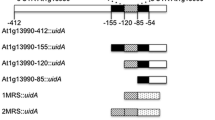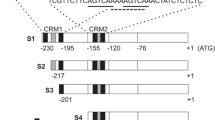Abstract
Plants recognize pathogens by microbe-associated molecular patterns (MAMPs) and subsequently induce an immune response. The regulation of gene expression during the immune response depends largely on cis-sequences conserved in promoters of MAMP-responsive genes. These cis-sequences can be analyzed by constructing synthetic promoters linked to a reporter gene and by testing these constructs in transient expression systems. Here, the use of the parsley (Petroselinum crispum) protoplast system for analyzing MAMP-responsive synthetic promoters is described. The synthetic promoter consists of four copies of a potential MAMP-responsive cis-sequence cloned upstream of a minimal promoter and the uidA reporter gene. The reporter plasmid contains a second reporter gene, which is constitutively expressed and hence eliminates the requirement of a second plasmid used as a transformation control. The reporter plasmid is transformed into parsley protoplasts that are elicited by the MAMP Pep25. The MAMP responsiveness is validated by comparing the reporter gene activity from MAMP-treated and untreated cells and by normalizing reporter gene activity using the constitutively expressed reporter gene.
Access this chapter
Tax calculation will be finalised at checkout
Purchases are for personal use only
Similar content being viewed by others
References
Tena G, Boudsocq M, Sheen J (2011) Protein kinase signaling networks in plant innate immunity. Curr Opin Plant Biol 14(5):519–529
Gurr SJ, Rushton PJ (2005) Engineering plants with increased disease resistance: how are we going to express it? Trends Biotechnol 23(6):283–290
Liu W, Stewart CN Jr (2016) Plant synthetic promoters and transcription factors. Curr Opin Biotechnol 37:36–44. doi:10.1016/j.copbio.2015.10.001
Niemeyer J, Ruhe J, Machens F, Stahl DJ, Hehl R (2014) Inducible expression of p50 from TMV for increased resistance to bacterial crown gall disease in tobacco. Plant Mol Biol 84:111–123. doi:10.1007/s11103-013-0122-4
Harb A, Krishnan A, Ambavaram MM, Pereira A (2010) Molecular and physiological analysis of drought stress in Arabidopsis reveals early responses leading to acclimation in plant growth. Plant Physiol 154(3):1254–1271. doi:10.1104/pp.110.161752
Zou C, Sun K, Mackaluso JD, Seddon AE, Jin R, Thomashow MF, Shiu SH (2011) Cis-regulatory code of stress-responsive transcription in Arabidopsis thaliana. Proc Natl Acad Sci U S A 108(36):14992–14997. doi:10.1073/pnas.1103202108
Koschmann J, Machens F, Becker M, Niemeyer J, Schulze J, Bülow L, Stahl DJ, Hehl R (2012) Integration of bioinformatics and synthetic promoters leads to the discovery of novel elicitor-responsive cis-regulatory sequences in Arabidopsis. Plant Physiol 160:178–191. doi:10.1104/pp.112.198259
Liu W, Mazarei M, Peng Y, Fethe MH, Rudis MR, Lin J, Millwood RJ, Arelli PR, Stewart CN Jr (2014) Computational discovery of soybean promoter cis-regulatory elements for the construction of soybean cyst nematode-inducible synthetic promoters. Plant Biotechnol J 12(8):1015–1026. doi:10.1111/pbi.12206
Dubos C, Kelemen Z, Sebastian A, Bülow L, Huep G, Xu W, Grain D, Salsac F, Brousse C, Lepiniec L, Weisshaar B, Contreras-Moreira B, Hehl R (2014) Integrating bioinformatic resources to predict transcription factors interacting with cis-sequences conserved in co-regulated genes. BMC Genomics 15(1):317. doi:10.1186/1471-2164-15-317
Sprenger-Haussels M, Weisshaar B (2000) Transactivation properties of parsley proline-rich bZIP transcription factors. Plant J 22(1):1–8
Rushton PJ, Reinstadler A, Lipka V, Lippok B, Somssich IE (2002) Synthetic plant promoters containing defined regulatory elements provide novel insights into pathogen- and wound-induced signaling. Plant Cell 14(4):749–762
Hahlbrock K, Scheel D, Logemann E, Nürnberger T, Parniske M, Reinold S, Sacks W, Schmelzer E (1995) Oligopeptide elicitor-mediated defense gene activation in cultured parsley cells. Proc Natl Acad Sci U S A 92:4150–4157
Nürnberger T, Nennstiel D, Jabs T, Sacks WR, Hahlbrock K, Scheel D (1994) High affinity binding of a fungal oligopeptide elicitor to parsley plasma membranes triggers multiple defense responses. Cell 78(3):449–460
Rushton PJ, Torres JT, Parniske M, Wernert P, Hahlbrock K, Somssich IE (1996) Interaction of elicitor-induced DNA-binding proteins with elicitor response elements in the promoters of parsley PR1 genes. EMBO J 15(20):5690–5700
Stahl DJ, Kloos DU, Hehl R (2004) A sugar beet chlorophyll a/b binding protein promoter void of G-box like elements confers strong and leaf specific reporter gene expression in transgenic sugar beet. BMC Biotechnol 4(1):31
van de Löcht U, Meier I, Hahlbrock K, Somssich IE (1990) A 125 bp promoter fragment is sufficient for strong elicitor-mediated gene activation in parsley. EMBO J 9(9):2945–2950
Kirsch C, Takamiya-Wik M, Schmelzer E, Hahlbrock K, Somssich IE (2000) A novel regulatory element involved in rapid activation of parsley ELI7 gene family members by fungal elicitor or pathogen infection. Mol Plant Pathol 1(4):243–251. doi:10.1046/j.1364-3703.2000.00029.x
Machens F, Becker M, Umrath F, Hehl R (2014) Identification of a novel type of WRKY transcription factor binding site in elicitor-responsive cis-sequences from Arabidopsis thaliana. Plant Mol Biol 84:371–385. doi:10.1007/s11103-013-0136-y
Lehmeyer M, Kanofsky K, Hanko EKR, Ahrendt S, Wehrs M, Machens F, Hehl R (2016) Functional dissection of a strong and specific microbe-associated molecular pattern-responsive synthetic promoter. Plant Biotechnol J 14(1):61–71. doi:10.1111/pbj12357
Lehmeyer M, Hanko EKR, Roling L, Gonzalez L, Wehrs M, Hehl R (2016) A cis-regulatory sequence from a short intergenic region gives rise to a strong microbe-associated molecular pattern-responsive synthetic promoter. Mol Genet Genomics 291(3):1155–1165. doi:10.1007/s00438-016-1173-4
Singh KB (1998) Transcriptional regulation in plants: the importance of combinatorial control. Plant Physiol 118(4):1111–1120
Acknowledgements
This work was supported by the KWS SAAT AG, Einbeck, Germany.
Author information
Authors and Affiliations
Corresponding author
Editor information
Editors and Affiliations
Rights and permissions
Copyright information
© 2016 Springer Science+Business Media New York
About this protocol
Cite this protocol
Kanofsky, K., Lehmeyer, M., Schulze, J., Hehl, R. (2016). Analysis of Microbe-Associated Molecular Pattern-Responsive Synthetic Promoters with the Parsley Protoplast System. In: Hehl, R. (eds) Plant Synthetic Promoters. Methods in Molecular Biology, vol 1482. Humana Press, New York, NY. https://doi.org/10.1007/978-1-4939-6396-6_11
Download citation
DOI: https://doi.org/10.1007/978-1-4939-6396-6_11
Published:
Publisher Name: Humana Press, New York, NY
Print ISBN: 978-1-4939-6394-2
Online ISBN: 978-1-4939-6396-6
eBook Packages: Springer Protocols




